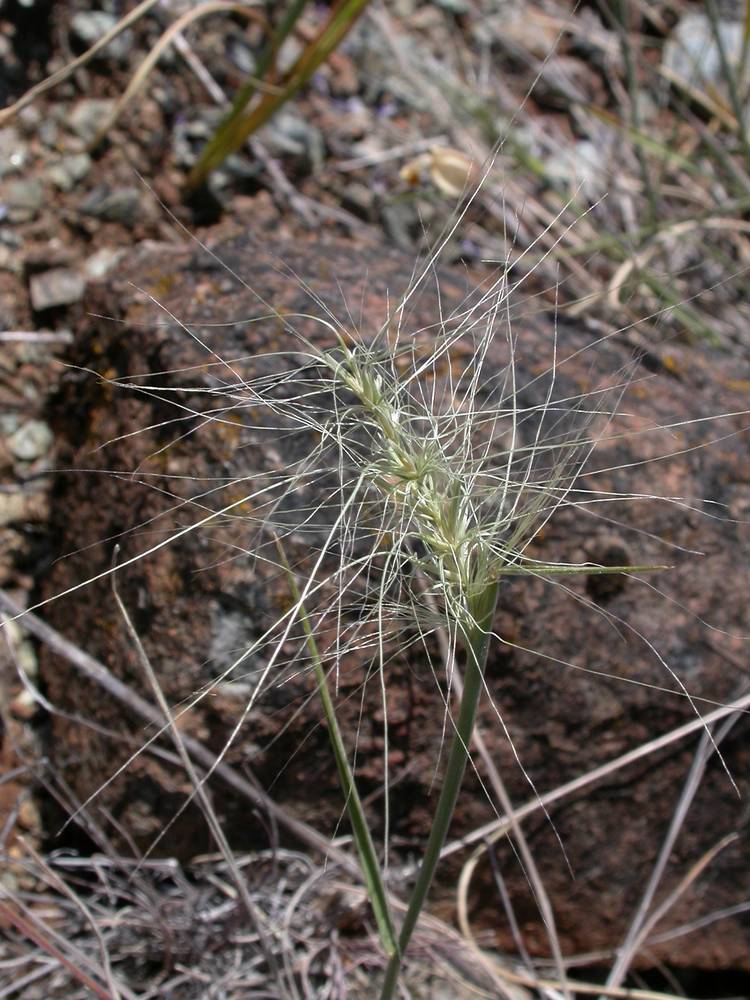Elymus multisetus
Elymus violaceus
(synonym of Elymus alaskanus)
big squirreltail
high wheatgrass
erect to ascending.
often decumbent or geniculate.
sheaths glabrous or white-villous;
blades 1.5–4 mm wide;
upper surfaces scabrous or hairy.
sheaths glabrous;
blades 3–4 mm wide, glabrous or hairy;
lower surfaces less densely hairy and with shorter hairs than the upper surfaces.
5–20 cm; erect, sometimes partially enclosed in the sheath of the uppermost leaf, 2 spikelets per node or rarely 3–4 at some nodes;
internodes 3–5(8)mm;
disarticulation initially at the rachis nodes; later beneath each floret.
(3)5–9 cm; erect, 1 spikelet per node;
internodes 4–5.5 mm;
disarticulation above the glumes; beneath each floret.
10–15 mm, divergent, 2–4 florets; lowest florets sterile and glume-like in 1 or both spikelets at each node.
(9)10–15(17)mm, appressed; (3)4–5 florets;
rachillas hairy;
hairs about 0.4 mm.
(10)30–100 mm including the awns; the bases hard and glabrous;
glume bodies about (2)5–10 × 1–2 mm, setaceous, 2–3-veined;
margins firm;
glume awns (8)25–90 mm; each split above the base into 3–9 unequal divisions, scabrous, flexuous to outcurving from near the bases at maturity.
8–12 × 1.2– 2 mm; about 75% as long as to equaling the adjacent lemmas, narrowly ovate to obovate, often purplish, glabrous or occasionally scabrous;
keels smooth but occasionally scabrous, 3(5)-veined, glabrous;
margins unequal; the wider margin 0.3– 1 mm wide, usually widest in the distal 33%;
tips acute to rounded, often awned;
glume awns; if present; to 2 mm.
fertile lemmas 8–10 mm; smooth or scabrous near the tips, 2 lateral veins extending into bristles to 10 mm;
lemma awns (10)20– 110 × 0.2 mm at the base, divergent to arching.
(6.4)8–9.5 mm, glabrous to pubescent; all similar, usually awned;
lemma awns; if present, 0.5–3 mm; straight.
1–2 mm.
0.7–1.3 mm.
=28.
Elymus multisetus
Elymus violaceus
Dry, often rocky grasslands and savannas. 50–2000m. BR, Col, ECas, Lava, Sisk, WV. CA, ID, NV, WA; southeast to CO, south to Mexico. Native.
Elymus multisetus has inflorescences that fall apart at maturity and glumes that are divided into three to nine widely spreading awns. Very similar E. elymoides has glumes that are entire or unevenly split into two to three parts. Determining how much the glumes are split is complicated by the presence of glumelike sterile lemmas in both E. multisetus and some E. elymoides subspecies. Elymus multisetus glumes are divided above the base. If the glumes appear to be divided to the base, the plant is more likely to be E. elymoides.
Dry to moist alpine meadows, talus, and shores of lakes and creeks. 2100–3000m. BW. ID, NV, WA; North to AK, northeast to Greenland, east to WY, southeast to NM. Native.
Elymus violaceus was recently split taxonomically from E. trachycaulus. Elymus violaceus has shorter anthers and more uneven glume margins than E. trachycaulus. Elymus trachycaulus growing at high elevations often has 3(5) glume veins and somewhat unequal glume margins, thus resembling E. violaceus.
Barbara Wilson, Richard Brainerd, Nick Otting
Barbara Wilson, Richard Brainerd, Nick Otting
- Local floras:
CA,
OR,
WA
- Local Web sites:
CalFlora,
CalPhotos,
Flora NW,
PNW Herbaria
WildflowerSearch
iNaturalist (observations)
USDA Plants Database
- LBJ Wildflower Center
- SEINet
- Plants of the World Online
- Encyclopedia of Life
- Wikipedia
- Google Image Search




